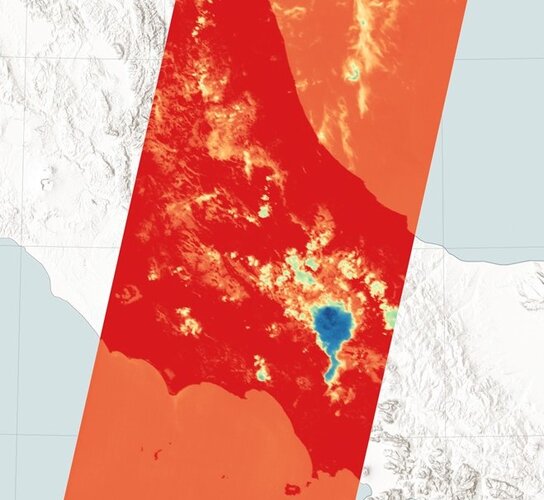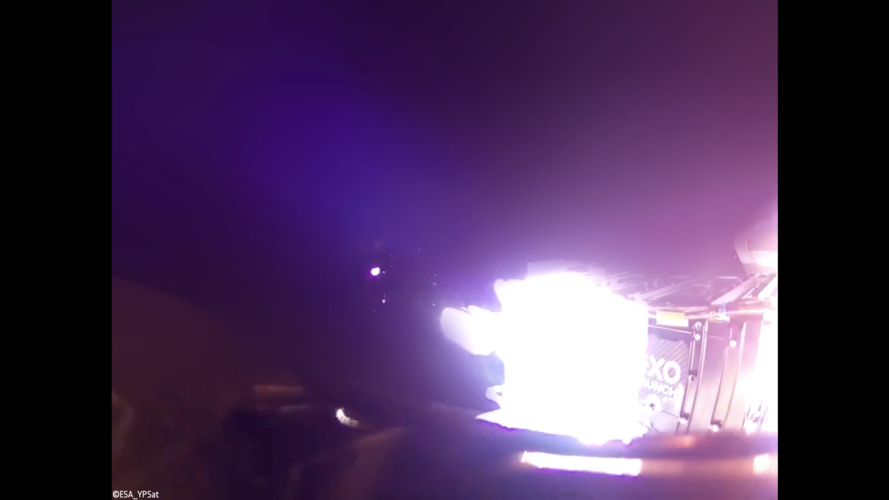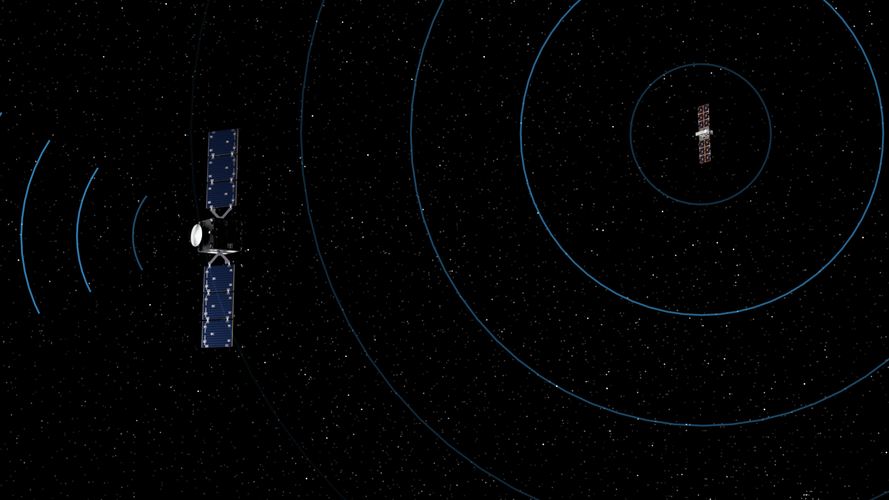Star Catcher banks $12.25 million for orbital energy grid
Wednesday, 24 July 2024 12:00

EarthCARE’s multispectral imager puts clouds into context
Wednesday, 24 July 2024 08:36
Launched less than two months ago, ESA’s EarthCARE satellite has already returned images from two of its four instruments. Now, it has also delivered the first images from its multispectral imager, showcasing various types of clouds and cloud temperatures worldwide. This instrument is set to add valuable context to the data from EarthCARE’s other instruments.
YPSat witnesses ISTSat-1 & 3Cat-4 CubeSats deployment from Ariane 6
Wednesday, 24 July 2024 08:00 Video:
00:00:15
Video:
00:00:15
Video returned from the ESA Young Professionals Satellite payload, YPSat, attached to the upper stage of the inaugural Ariane 6 rocket, launched on 9 July 2024. This clip shows two cubesats deployment into orbit from the Exolaunch dispenser: The first CubeSat is ISTSat-1 and the second is 3Cat-4, both supported by ESA Education initiatives. The video has been enhanced to highlight these events, that were part of the key mission objectives for YPSat. The YPSat project represents the culmination of about two and a half years of dedication and hard work core team of about 30 Young
Hera spacecraft trio to fly safe with inter-linked radio
Wednesday, 24 July 2024 06:55
ESA’s Hera mission for planetary defence involves not just one spacecraft but three: two shoebox-sized CubeSats will fly up to a few dozen kilometres away from their mothership around the Didymos binary asteroid system. Keeping this trio in communication to fulfil their own mission needs while also ensuring their safe separation is the task of a novel inter-satellite link radio technology, produced by a Portuguese company best known for terrestrial drone systems.
Review concludes proposed NASA budget cuts would end Chandra
Wednesday, 24 July 2024 04:12

Astroscale UK Wins Contract for Final Phase of ELSA-M Demonstration
Tuesday, 23 July 2024 22:46 Astroscale Ltd ("Astroscale UK"), a subsidiary of Astroscale Holdings Inc. ("Astroscale"), has secured EUR 13.95 million (approximately USD 15 million or GBP 11.78 million) from the UK Space Agency and the European Space Agency ("ESA") for the final phase of the End-of-Life by Astroscale-Multiple (ELSA-M) in-orbit demonstration.
The funding follows a contract with Eutelsat OneWeb as part o
Astroscale Ltd ("Astroscale UK"), a subsidiary of Astroscale Holdings Inc. ("Astroscale"), has secured EUR 13.95 million (approximately USD 15 million or GBP 11.78 million) from the UK Space Agency and the European Space Agency ("ESA") for the final phase of the End-of-Life by Astroscale-Multiple (ELSA-M) in-orbit demonstration.
The funding follows a contract with Eutelsat OneWeb as part o New Insight into Supermassive Black Hole Mergers and Dark Matter
Tuesday, 23 July 2024 22:46 Researchers have identified a crucial link between supermassive black holes (SMBHs) and dark matter particles, shedding light on the "final parsec problem" in astrophysics.
New calculations suggest that the merger of SMBH pairs into a single entity is facilitated by the previously underestimated behavior of dark matter particles. This discovery offers a potential solution to the "final par
Researchers have identified a crucial link between supermassive black holes (SMBHs) and dark matter particles, shedding light on the "final parsec problem" in astrophysics.
New calculations suggest that the merger of SMBH pairs into a single entity is facilitated by the previously underestimated behavior of dark matter particles. This discovery offers a potential solution to the "final par Quantum Particles Energy Landscape Theory Unveiled by Physicists
Tuesday, 23 July 2024 22:46 An international team of physicists, based at Trinity College Dublin, has formulated new theorems in quantum mechanics that define the "energy landscapes" of quantum particle collections. This work addresses long-standing questions, paving the way for more accurate computer simulations of materials, which could aid in developing new green technologies.
The theorems, recently published in t
An international team of physicists, based at Trinity College Dublin, has formulated new theorems in quantum mechanics that define the "energy landscapes" of quantum particle collections. This work addresses long-standing questions, paving the way for more accurate computer simulations of materials, which could aid in developing new green technologies.
The theorems, recently published in t New Magnetic Criteria Suggest Only Two Exoplanets Potentially Habitable
Tuesday, 23 July 2024 22:46 Interest in Earth-like planets within the habitable zone of their stars has surged, driven by the quest to find life beyond our solar system. However, the potential habitability of such planets, known as exoplanets, depends on more than just their distance from the star.
A new study by Rice University's David Alexander and Anthony Atkinson broadens the definition of a habitable zone to inc
Interest in Earth-like planets within the habitable zone of their stars has surged, driven by the quest to find life beyond our solar system. However, the potential habitability of such planets, known as exoplanets, depends on more than just their distance from the star.
A new study by Rice University's David Alexander and Anthony Atkinson broadens the definition of a habitable zone to inc Deep-Ocean Minerals Generate Oxygen at 13,000 Feet Below Surface
Tuesday, 23 July 2024 22:46 An international team of researchers, including a chemist from Northwestern University, has discovered that metallic minerals on the deep-ocean floor can produce oxygen at depths of 13,000 feet.
This finding challenges the traditional belief that only photosynthetic organisms, such as plants and algae, generate Earth's oxygen. The discovery suggests oxygen can also be produced at the seafl
An international team of researchers, including a chemist from Northwestern University, has discovered that metallic minerals on the deep-ocean floor can produce oxygen at depths of 13,000 feet.
This finding challenges the traditional belief that only photosynthetic organisms, such as plants and algae, generate Earth's oxygen. The discovery suggests oxygen can also be produced at the seafl Queen's University Belfast Researchers Investigate Mysterious Brightening of Chiron
Tuesday, 23 July 2024 22:46 Planetary astronomers at Queen's University Belfast have delved into one of the Solar System's enduring enigmas: the unusual behavior of Chiron.
Discovered in 1977 and initially classified as an asteroid, Chiron was the first recognized member of the Centaurs, a new class of Solar System objects. The Centaurs inhabit short-lived orbits between the asteroid belt and the Kuiper belt, a dista
Planetary astronomers at Queen's University Belfast have delved into one of the Solar System's enduring enigmas: the unusual behavior of Chiron.
Discovered in 1977 and initially classified as an asteroid, Chiron was the first recognized member of the Centaurs, a new class of Solar System objects. The Centaurs inhabit short-lived orbits between the asteroid belt and the Kuiper belt, a dista NASA picks next 4 crew members for simulated Mars mission in Texas
Tuesday, 23 July 2024 22:46 The third volunteer research team to participate in NASA's simulated mission to Mars has been picked as the United States aims to better understand how humans will react during a deep-space mission, the space agency said Monday.
Erin Anderson, Sergii Iakymov, Brandon Kent and Sarah Elizabeth McCandless are to begin their simulated trek to Mars within NASA's Human Exploration Research An
The third volunteer research team to participate in NASA's simulated mission to Mars has been picked as the United States aims to better understand how humans will react during a deep-space mission, the space agency said Monday.
Erin Anderson, Sergii Iakymov, Brandon Kent and Sarah Elizabeth McCandless are to begin their simulated trek to Mars within NASA's Human Exploration Research An BAE Systems and Stellar Blu Complete Certification for In-Flight Connectivity Antenna
Tuesday, 23 July 2024 22:46 BAE Systems' (LON: BA) partner Stellar Blu Solutions has successfully completed the qualification and received supplemental type certification for the multi-orbit Sidewinder aero terminal. This terminal utilizes BAE Systems' Ku-band electronically scanned antenna (ESA) and is now ready for mass production and installation to enhance in-flight connectivity (IFC) on commercial aircraft, business j
BAE Systems' (LON: BA) partner Stellar Blu Solutions has successfully completed the qualification and received supplemental type certification for the multi-orbit Sidewinder aero terminal. This terminal utilizes BAE Systems' Ku-band electronically scanned antenna (ESA) and is now ready for mass production and installation to enhance in-flight connectivity (IFC) on commercial aircraft, business j 



